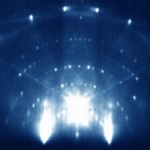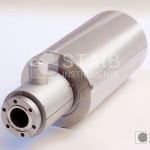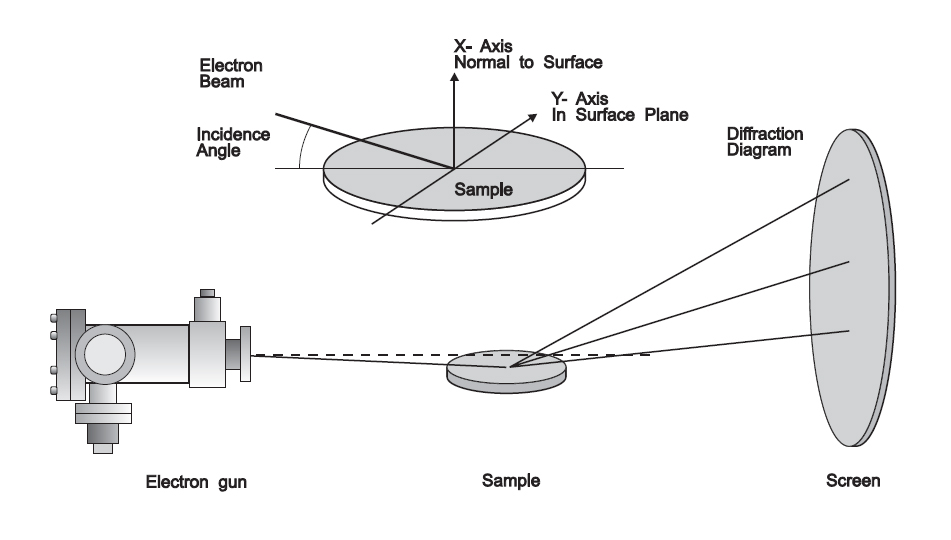RHEEDOliverToon2017-03-23T16:39:47+01:00

Reflection High Energy Electron Diffraction (RHEED)
is a powerful technique for studying the structures of crystal samples in a wide variety of research and process chambers.

Electrons can be diffracted by a surface in a similar way as visible light, except that the associated wavelength is much smaller. Low energy electrons have a wavelength that is in the order of atomic spacing and can be diffracted by lattice atoms. High energy electrons have a wavelength much smaller than the lattice spacing and diffraction conditions can be reached simply by setting the incident beam at a very small incidence angle to the surface. The diffracted electrons build a diagram consisting of a superposition of spots at Bragg angles for the bulk material, streaks from the surface diffraction, and Kikuchi lines from channeling effects.
 The ability to monitor variations of the diagram during deposition is most valuable. RHEED delivers real time detailed information about the crystal structure of the bulk and the smoothness and crystalline quality of the surface layer with a sub-monolayer resolution. When used in a deposition device, the diffraction diagram instantly displays the surface modifications. The intensity of diffraction spots or streaks is used to monitor the deposition at a layer-by-layer sensitivity (technique named RHEED oscillations).
The ability to monitor variations of the diagram during deposition is most valuable. RHEED delivers real time detailed information about the crystal structure of the bulk and the smoothness and crystalline quality of the surface layer with a sub-monolayer resolution. When used in a deposition device, the diffraction diagram instantly displays the surface modifications. The intensity of diffraction spots or streaks is used to monitor the deposition at a layer-by-layer sensitivity (technique named RHEED oscillations).
RHEED is the premium choice technique for growth monitoring since multiple different parameters can be captured simultaneousley in situ, and in real time.
In order to produce sharp diffraction spots, the high energy primary RHEED beam (typically above 10 keV) must be of small size, and highly collimated. Electron guns for RHEED fulfill these requirements using suitable electron optical lenses, which allow full electronic control of the beam parameters. The electron gun is mounted at grazing incidence angle towards the sample surface. The diffracted electrons are imaged on a fluorescent screen mounted on the opposite side of the sample. The screen can be protected with a shutter when not in use. The diffraction diagram displayed is digitalized using a CCD camera.
The video feed can be analyzed in a suitable RHEED acquisition software. Here, the area of interest can be set on the RHEED diagram to follow the signal intensity variations, which can be instantly converted into growth rate and layer thickness.
The standard setup requires an electron gun suitable for RHEED with an energy in the range of 10 to 60 keV. The electron gun is mounted onto the vacuum chamber to achieve a glazing incidence angle to the surface. The angle to the surface should be adjustable in the range of 1 to 3 degrees. Previously, this has been done using precise mechanical orienters. Today state-of-the-art uses a very precise
electronic beam rocking control (
For RHEED analysis, the electron beam must impinge onto the surface at grazing incidence.
The unique STAIB feature, beam rocking, allows precise adjustment and variation of the incidence angle using electronic controls, without moving the sample. Electron sources from STAIB Instruments are uniquely designed to allow this precise electronic control of the beam position using sophisticated electron beam deflection optics.
When equipped with the beam rocking option, specially designed optics shift the electron path off axis in the gun and refocus it onto the sample, maintaining the spot position. In this way, the incidence angle can be precisely controlled electronically without either modifications of the geometry of the gun or motion of the sample. The electron gun can be mounted on the vacuum chamber without using a bellows for mechanical adjustment. The beam rocking option is very helpful in critical cases where the sample position cannot be adjusted easily during the growth. In these cases, beam rocking allows precise variation of the incidence angle.
STAIB Instruments has designed a patented system of beam steering that electronically controls the beam position and beam incidence angle.
With the patented STAIB TorrRHEED™, the incident angel can be changed with a unique double deflection system. The beam can easily be manipulated on the substrate without changing the mechanical alignment. This gives the operator the desired degrees of freedom for easy and simple alignment of the RHEED setup. RHEED diffraction conditions can be quickly and reproducibly fine tuned at any time, without the cumbersome mechanical manipulation approach used by other manufacturers.
. The distance between gun and sample can be quite large to allow full clearance around the sample. The multilayer fluorescent screen includes a special phosphorous deposited on lead glass (to block X-rays generated in the chamber). It is designed to enhance contrast by blocking light and low energy electrons from inside the chamber. A shutter can be used to protect the screen and extend its lifetime.
The acquisition and digitalization of the diffraction diagrams is performed by a low noise CCD camera with selectable sensitivity and speed. Changes of the crystal structure, the number of layers deposited, and the deposition rate can be measured during the process simultaneousley.
- Beam rocking capability to electronically fine adjust the incidence angle.
- A high beam energy option for operation of RHEED in large vessels, or in order to work with poorly diffracting samples (high energy allows more bulk diffraction) and samples with poor and complex crystal structures (such as textures, nanofibers). High energy guns of 100 keV are also used for gas diffraction.
- Addition of pumping stage (differential pumping) to the electron gun allows it to work under poor vacuum conditions (TorrRHEEDTM), a common requirement for many deposition systems, such as PLD, IBD, MOMBE and more.
- Blanking the electron beam (beam blanking) allows fast control of the beam (switching on/off) that can be used for rotating samples and to drastically reduce the electron impact effects on electron sensitive surfaces (organic materials).
to best customize a system to specific customer’s applications. STAIB also offers many standard and special accessories to RHEED systems, further allowing for individual customization.
|
|
RHEED guns from STAIB Instruments are available as standard, short and super short designs and come with many different options and accessories. More info
|
|
|
STAIB Instruments offers a solution for RHEED at high pressures for applications requiring a higher gas pressure during growth, such as PLD, Laser MBE, and CVD. More info |
|
|
STAIB also offers complete RHEED solutions for different applications especially addressing challenging growth environments and very large substrate sizes. More info |
|
|
In addition, STAIB Instruments offers a variety of useful accessories which can be ordered with the RHEED gun. More info |
|
|
RHEED Vision is a powerful data acquisition tool adaptable to every existing RHEED system. More info
|
 Electrons can be diffracted by a surface in a similar way as visible light, except that the associated wavelength is much smaller. Low energy electrons have a wavelength that is in the order of atomic spacing and can be diffracted by lattice atoms. High energy electrons have a wavelength much smaller than the lattice spacing and diffraction conditions can be reached simply by setting the incident beam at a very small incidence angle to the surface. The diffracted electrons build a diagram consisting of a superposition of spots at Bragg angles for the bulk material, streaks from the surface diffraction, and Kikuchi lines from channeling effects.
Electrons can be diffracted by a surface in a similar way as visible light, except that the associated wavelength is much smaller. Low energy electrons have a wavelength that is in the order of atomic spacing and can be diffracted by lattice atoms. High energy electrons have a wavelength much smaller than the lattice spacing and diffraction conditions can be reached simply by setting the incident beam at a very small incidence angle to the surface. The diffracted electrons build a diagram consisting of a superposition of spots at Bragg angles for the bulk material, streaks from the surface diffraction, and Kikuchi lines from channeling effects.
 The ability to monitor variations of the diagram during deposition is most valuable. RHEED delivers real time detailed information about the crystal structure of the bulk and the smoothness and crystalline quality of the surface layer with a sub-monolayer resolution. When used in a deposition device, the diffraction diagram instantly displays the surface modifications. The intensity of diffraction spots or streaks is used to monitor the deposition at a layer-by-layer sensitivity (technique named RHEED oscillations).
The ability to monitor variations of the diagram during deposition is most valuable. RHEED delivers real time detailed information about the crystal structure of the bulk and the smoothness and crystalline quality of the surface layer with a sub-monolayer resolution. When used in a deposition device, the diffraction diagram instantly displays the surface modifications. The intensity of diffraction spots or streaks is used to monitor the deposition at a layer-by-layer sensitivity (technique named RHEED oscillations).
